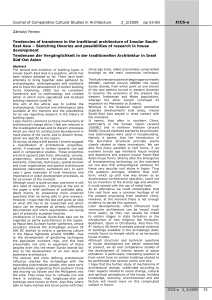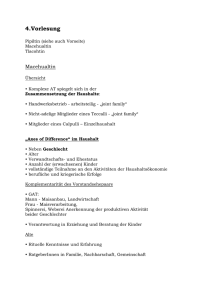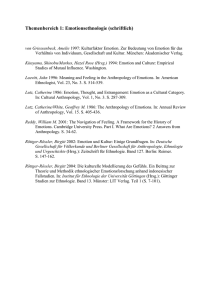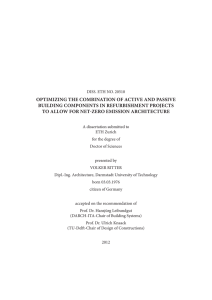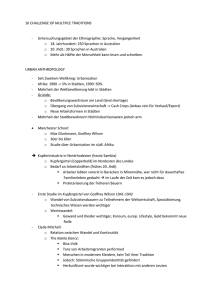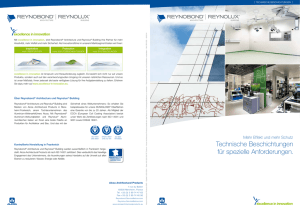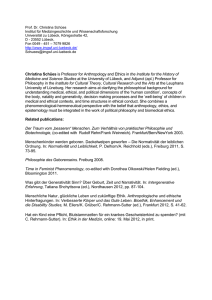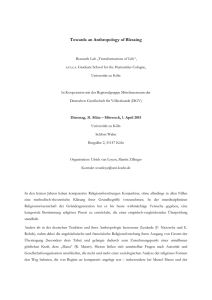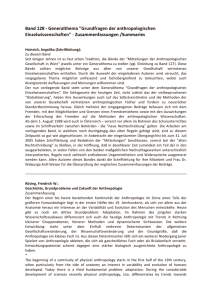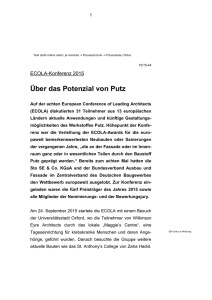Architektur-Anthropologie
Werbung
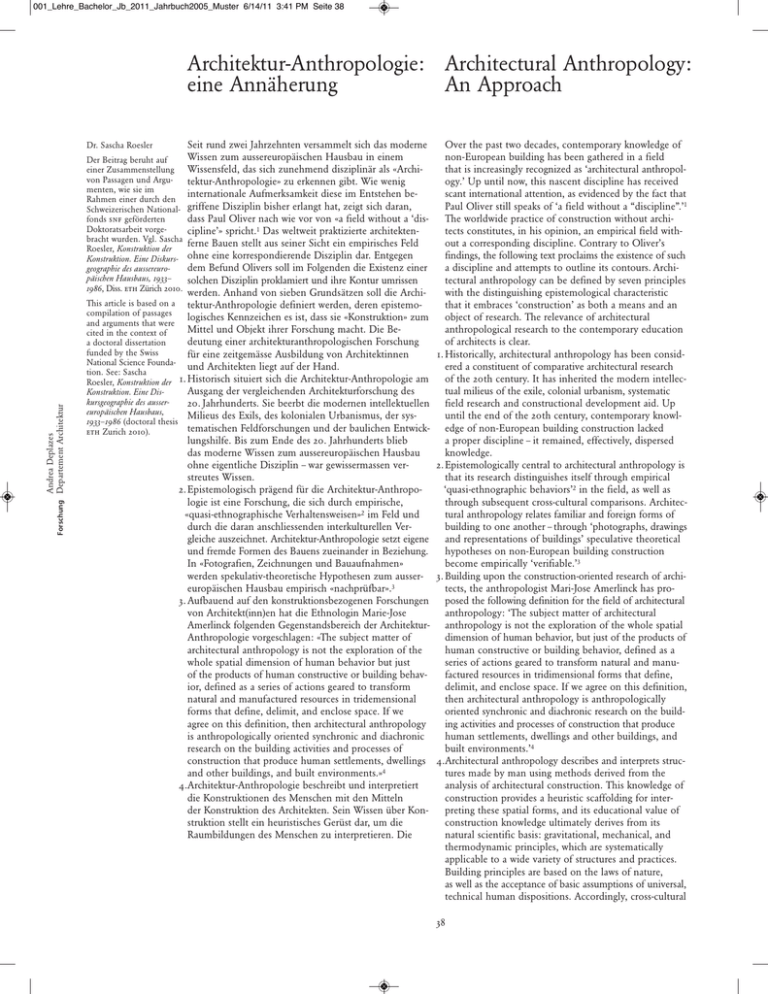
001_Lehre_Bachelor_Jb_2011_Jahrbuch2005_Muster 6/14/11 3:41 PM Seite 38 Architektur-Anthropologie: Architectural Anthropology: eine Annäherung An Approach Seit rund zwei Jahrzehnten versammelt sich das moderne Wissen zum aussereuropäischen Hausbau in einem Der Beitrag beruht auf Wissensfeld, das sich zunehmend disziplinär als «Archieiner Zusammenstellung von Passagen und Argutektur-Anthropologie» zu erkennen gibt. Wie wenig menten, wie sie im internationale Aufmerksamkeit diese im Entstehen beRahmen einer durch den Schweizerischen National- griffene Disziplin bisher erlangt hat, zeigt sich daran, dass Paul Oliver nach wie vor von «a field without a ‘disfonds snf geförderten Doktoratsarbeit vorgecipline’» spricht.1 Das weltweit praktizierte architektenbracht wurden. Vgl. Sascha ferne Bauen stellt aus seiner Sicht ein empirisches Feld Roesler, Konstruktion der Konstruktion. Eine Diskurs- ohne eine korrespondierende Disziplin dar. Entgegen dem Befund Olivers soll im Folgenden die Existenz einer geographie des aussereuropäischen Hausbaus, 1933– solchen Disziplin proklamiert und ihre Kontur umrissen 1986, Diss. eth Zürich 2010. werden. Anhand von sieben Grundsätzen soll die ArchiThis article is based on a tektur-Anthropologie definiert werden, deren epistemocompilation of passages logisches Kennzeichen es ist, dass sie «Konstruktion» zum and arguments that were Mittel und Objekt ihrer Forschung macht. Die Becited in the context of deutung einer architekturanthropologischen Forschung a doctoral dissertation funded by the Swiss für eine zeitgemässe Ausbildung von Architektinnen National Science Foundaund Architekten liegt auf der Hand. tion. See: Sascha Roesler, Konstruktion der 1. Historisch situiert sich die Architektur-Anthropologie am Ausgang der vergleichenden Architekturforschung des Konstruktion. Eine Diskursgeographie des ausser20. Jahrhunderts. Sie beerbt die modernen intellektuellen europäischen Hausbaus, Milieus des Exils, des kolonialen Urbanismus, der sys1933–1986 (doctoral thesis tematischen Feldforschungen und der baulichen Entwicketh Zurich 2010). lungshilfe. Bis zum Ende des 20. Jahrhunderts blieb das moderne Wissen zum aussereuropäischen Hausbau ohne eigentliche Disziplin – war gewissermassen verstreutes Wissen. 2. Epistemologisch prägend für die Architektur-Anthropologie ist eine Forschung, die sich durch empirische, «quasi-ethnographische Verhaltensweisen»2 im Feld und durch die daran anschliessenden interkulturellen Vergleiche auszeichnet. Architektur-Anthropologie setzt eigene und fremde Formen des Bauens zueinander in Beziehung. In «Fotografien, Zeichnungen und Bauaufnahmen» werden spekulativ-theoretische Hypothesen zum aussereuropäischen Hausbau empirisch «nachprüfbar».3 3. Aufbauend auf den konstruktionsbezogenen Forschungen von Architekt(inn)en hat die Ethnologin Marie-Jose Amerlinck folgenden Gegenstandsbereich der ArchitekturAnthropologie vorgeschlagen: «The subject matter of architectural anthropology is not the exploration of the whole spatial dimension of human behavior but just of the products of human constructive or building behavior, defined as a series of actions geared to transform natural and manufactured resources in tridemensional forms that define, delimit, and enclose space. If we agree on this definition, then architectural anthropology is anthropologically oriented synchronic and diachronic research on the building activities and processes of construction that produce human settlements, dwellings and other buildings, and built environments.»4 4.Architektur-Anthropologie beschreibt und interpretiert die Konstruktionen des Menschen mit den Mitteln der Konstruktion des Architekten. Sein Wissen über Konstruktion stellt ein heuristisches Gerüst dar, um die Raumbildungen des Menschen zu interpretieren. Die Andrea Deplazes Forschung Departement Architektur Dr. Sascha Roesler Over the past two decades, contemporary knowledge of non-European building has been gathered in a field that is increasingly recognized as ‘architectural anthropology.’ Up until now, this nascent discipline has received scant international attention, as evidenced by the fact that Paul Oliver still speaks of ‘a field without a “discipline”.’1 The worldwide practice of construction without architects constitutes, in his opinion, an empirical field without a corresponding discipline. Contrary to Oliver’s findings, the following text proclaims the existence of such a discipline and attempts to outline its contours. Architectural anthropology can be defined by seven principles with the distinguishing epistemological characteristic that it embraces ‘construction’ as both a means and an object of research. The relevance of architectural anthropological research to the contemporary education of architects is clear. 1. Historically, architectural anthropology has been considered a constituent of comparative architectural research of the 20th century. It has inherited the modern intellectual milieus of the exile, colonial urbanism, systematic field research and constructional development aid. Up until the end of the 20th century, contemporary knowledge of non-European building construction lacked a proper discipline – it remained, effectively, dispersed knowledge. 2. Epistemologically central to architectural anthropology is that its research distinguishes itself through empirical ‘quasi-ethnographic behaviors’2 in the field, as well as through subsequent cross-cultural comparisons. Architectural anthropology relates familiar and foreign forms of building to one another – through ‘photographs, drawings and representations of buildings’ speculative theoretical hypotheses on non-European building construction become empirically ‘verifiable.’3 3. Building upon the construction-oriented research of architects, the anthropologist Mari-Jose Amerlinck has proposed the following definition for the field of architectural anthropology: ‘The subject matter of architectural anthropology is not the exploration of the whole spatial dimension of human behavior, but just of the products of human constructive or building behavior, defined as a series of actions geared to transform natural and manufactured resources in tridimensional forms that define, delimit, and enclose space. If we agree on this definition, then architectural anthropology is anthropologically oriented synchronic and diachronic research on the building activities and processes of construction that produce human settlements, dwellings and other buildings, and built environments.’4 4.Architectural anthropology describes and interprets structures made by man using methods derived from the analysis of architectural construction. This knowledge of construction provides a heuristic scaffolding for interpreting these spatial forms, and its educational value of construction knowledge ultimately derives from its natural scientific basis: gravitational, mechanical, and thermodynamic principles, which are systematically applicable to a wide variety of structures and practices. Building principles are based on the laws of nature, as well as the acceptance of basic assumptions of universal, technical human dispositions. Accordingly, cross-cultural 38 Forschung Departement Architektur heuristische Wirkung dieses Wissens geht letztlich comparisons can be made on the basis of material supauf dessen naturwissenschaftliche Basis zurück: Gesetze port (structure) and practical behaviors (construction). der Gravitation, Mechanik und Thermodynamik, die 5. Architectural anthropology makes accessible aspects of sich systematisch auf unterschiedlichste bauliche Gebilde construction that have been neglected in the context und Praktiken anwenden lassen. Konstruktionswissen of industrialized, western-oriented architecture. In particberuht auf Naturgesetzen sowie Annahmen einheitlicher ular, environmental and symbolic aspects of constructechnischer Grunddispositionen des Menschen. Der tion are manifested through architectural and anthropolinterkulturelle Vergleich erfolgt entsprechend auf der ogical research. An architectural-anthropologically Grundlage materieller Träger (Strukturen) und praktischer informed structure demonstrates sensitivity to the natural Verhaltensweisen (Bauen). context, the capacity for a constructional adaptation to 5. Architektur-Anthropologie erschliesst Aspekte des Bauens, this context, and a socio-culturally legitimate connection die im Umfeld einer industrialisierten Architektur westto local building expertise, as well as a structural flexilichen Zuschnitts vernachlässigt wurden. Insbesondere bility and adaptability to the needs of its users. umweltbezogene und symbolische Aspekte der Konstruk- 6.Architectural anthropology consolidates an interdisciplintion werden durch eine architekturanthropologische ary field of knowledge in which architects play a central Forschung greifbar. Eine architekturanthropologisch role, alongside anthropologists. In his foreword to Labelle informierte Konstruktion verfügt über eine Sensibilität für Prussin’s 1969 book Architecture in Northern Ghana, die natürliche Umgebung, über die Fähigkeit zur bauthe anthropologist Walter Goldschmidt pointed out the technischen Anpassung an diesen Kontext, über eine sozio- challenging consequences of a connection between kulturell legitimierte Verankerung in lokalen Fertigkeiten architecture and anthropology: ‘If an anthropology of sowie über die strukturelle Offenheit gegenüber einer architecture is to be established, it must be done by prozeduralen Anpassbarkeit an die Bedürfnisse der Nutzer. persons who have a thorough knowledge of both fields, 6.Architektur-Anthropologie vereinigt ein interdisziplinär who appreciate the essential character of the art of geprägtes Wissensfeld, in dem Architekt(inn)en – neben shaping space as well as the social and cultural context Ethnolog(inn)en – die zentrale Rolle spielen. Der in which these spatial forms must function.’5 Ethnologe Walter Goldschmidt hat in seinem Vorwort zu 7. Architectural anthropology is not (as referred to since the early 1960s) the architectural history of architecture Labelle Prussins 1969 publizierter Studie Architecture without architects. Architectural anthropology, just like in Nothern Ghana auf die herausfordernden Konsequenzen architectural history, takes a diachronic approach to einer Verknüpfung von Architektur und Anthropologie its objects of study, but just as importantly takes a synhingewiesen: «If an anthropology of architecture is to be chronic approach: architectural anthropology is in established, it must be done by persons who have a the hands of architects who argue from a constructional thorough knowledge of both fields, who appreciate the perspective. Insofar as architectural anthropology is essential character of the art of shaping space as well aligned with comparative research on construction by as the social and cultural context in which these spatial humans, it takes up a project that was presaged by forms must function.»5 Gottfried Semper around 150 years ago. Architectural 7. Architektur-Anthropologie ist nicht die (seit den frühen anthropology continues Semper’s unfinished disci1960er Jahren eingeforderte) Architekturgeschichtsplinary project for a comparative theory of architecture schreibung zum architektenfernen Bauen. Die Architektur(‘Vergleichende Baulehre’). Anthropologie verfügt zwar, wie die Architekturgeschichtsschreibung auch, über diachrone Zugänge zu ihren Gegenständen; ebenso wichtig sind jedoch syn1 Paul Oliver, Afterword – Raising 4Mari-Jose Amerlinck, ed., Archichrone: Architektur-Anthropologie ist in den Händen the Roof, in: Lindsay Asquith / tectural Anthropology (Westport, Marcel Vellinga, eds., Vernacular Conn./London: Bergin & Garvey von konstruktiv argumentierenden Architekten und Architecture in the Twenty2001), p. 3. Architektinnen. Indem Architektur-Anthropologie auf die First Century – Theory, Educa5 Walter Goldschmidt, ‘Foreword,’ vergleichende Erforschung der Konstruktion des Mention and Practice (London/ in Labelle Prussin, Architecture schen ausgerichtet ist, greift sie ein Projekt auf, das durch New York: Routledge 2006), p. 268. in Northern Ghana – A Study 2 Karin Jaschke, ‘Architects in the of Forms and Functions Gottfried Semper vor rund 150 Jahren vorgezeichnet Field – The African Journeys of (Berkley: University of California wurde. Architektur-Anthropologie beerbt disziplinär Aldo van Eyck and Herman Press 1969), p. ix. Sempers unvollendet gebliebene «Vergleichende Baulehre». Haan,’ Thesis – Wissenschaftliche 1 Paul Oliver, Afterword – Raising the Roof, in: Lindsay Asquith und Marcel Vellinga (Hg.), Vernacular Architecture in the TwentyFirst Century – Theory, Education and Practice, London/ New York 2006, S. 268. 2 Karin Jaschke, Architects in the Field – The African Journeys of Aldo van Eyck and Herman Haan, in: Thesis – Wissenschaftliche Zeitschrift der Bauhaus-Universität Weimar 49 (2003), H. 1, Die nützliche Reise, S. 20– 27, hier S. 21. 3 Gaudenz Domenig, Tektonik im primitiven Dachbau – Materialien und Rekonstruktionen zum Phänomen der auskragenden Giebel an alten Dachformen Ostasiens, Südostasiens und Ozeaniens – Ein architekturtheoretischer und bauethnologischer Versuch, Publikation im Rahmen der Ausstellung «Göttersitz und Menschenhaus», ETH Zürich, Zürich 1980, S. 118. 4Mari-Jose Amerlinck (Hg.), Architectural Anthropology, Westport, Conn./London 2001, S. 3. Zeitschrift der Bauhaus-Universität Weimar, 49, 1 (2003), 20–27 (p. 21). 3 Gaudenz Domenig, Tektonik im primitiven Dachbau – Materialien und Rekonstruktionen zum Phänomen der auskragenden Giebel an alten Dachformen Ostasiens, Südostasiens und Ozeaniens – Ein architekturtheoretischer und bauethnologischer Versuch, Publikation im Rahmen der Ausstellung «Göttersitz und Menschenhaus», ETH Zürich 1980, p. 118. 5 Walter Goldschmidt, Vorwort, in: Labelle Prussin, Architecture in Northern Ghana – A Study of Forms and Functions, Berkley 1969, S. ix. 39 Andrea Deplazes 001_Lehre_Bachelor_Jb_2011_Jahrbuch2005_Muster 6/14/11 3:41 PM Seite 39
